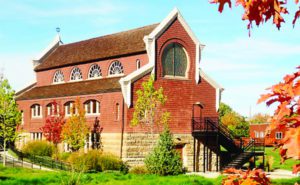CHANUKAH EDITION SECTION E PAGE 7
By Dan Fellner
BOISE, Idaho — Sometimes you’ll find the most splendid synagogues in the places you least expect.
Such was the case during my recent three-day trip to Boise, Idaho, a popular gateway for skiing, river rafting and hiking that isn’t exactly known for being a hotbed of Jewish life.
Yet at 11 N. Latah St., just a five-minute drive from downtown, sits the oldest continuously in-use synagogue west of the Mississippi River.
It’s more than just a beautiful wood building. Congregation Ahavath Beth Israel is the centerpiece of a surprisingly robust Jewish community with a fascinating history.
I was able to meet Nina Spiro, the synagogue’s director, who was kind enough to show me around the building on the busy day before Yom Kippur eve.
“People love this building,” she said. “We can’t believe how blessed we are. It’s cozy, it’s homey and the acoustics are great.”
Boise, a city of about 200,000 residents at the base of the Rocky Mountain foothills in southwestern Idaho, is the state’s capital and largest city.
Rooted in the potato industry, the area has recently emerged as a budding high-tech center and growing destination for tourists. The locals pronounce it “Boy-see,” not “Boy-zee.”
Before my visit, I had read about Ahavath Beth Israel and knew a little about its history. It was built in 1895, when there were only about 25 Jewish families in Boise. Many had emigrated to the US from Germany and worked as merchants, farmers, and ranchers.
One of the original members of Beth Israel — as it was known at the time — was Moses Alexander, who became the mayor of Boise and later was the first elected practicing Jewish governor in the entire country. He served two terms, from 1915-1919. There is a display at a museum inside the Idaho State Capitol in downtown Boise trumpeting that historical distinction.
To this day, Alexander remains the only Jewish governor in Idaho history.
Today, more than 120 years later, Moses’ grandson, Nathan Alexander, is still a member of the congregation.
For several decades, Boise actually had two synagogues.
After WW II, with the arrival of more Jewish families in the area, Congregation Ahavath Israel was built. The two congregations merged in 1987 to become the present-day Congregation Ahavath Beth Israel. Both buildings continued to be used; one as an education center, the other for religious services.
But by the end of the 20th century, the congregation had grown to more than 200 families and needed to expand. Due to the lack of land available where the existing buildings were located, the congregation decided that the original synagogue would need to be moved to a different site.
So, in the middle of a cold October night in 2003, members of the congregation were joined by some 500 people from the Boise community to walk alongside the synagogue while it was slowly moved by truck about three miles to its new location on Latah Street.
Today, the synagogue sits on a beautifully landscaped campus that also includes a 100-student religious school that meets weekly, a social hall, a library and administrative offices for the synagogue’s full-time rabbi and other staff.
The interior of the synagogue still features the original wood columns and stained-glass windows. It is listed in the National Register of Historic Places.
Since the community is so diverse in its religious orientation and the ages of its members — from retirees to young families — Spiro describes Ahavath Beth Israel as “reconservadox.”
While it tries to meet the needs of both religious and not-so-religious members, the congregation is affiliated with the Union for Reform Judaism and emphasizes music in its services and events.
In fact, the synagogue has its own klezmer band called “The Moody Jews,” a popular group that performs monthly at a temple event called “Shabbat Unplugged” and at community interfaith events.
But not all events surrounding the synagogue have been cheery.
Idaho has a reputation for being a haven of extremist hate groups. About 10 years ago, the Aryan Nation leafletted some Boise neighborhoods with anti-Semitic and racist literature. Spiro’s home was among those that received the offensive literature.
“It was pretty shocking,” she recalls. “Since then, a lot of work has been done.”
To demonstrate its tolerance, Boiseans have erected the Anne Frank Human Rights Memorial, which occupies a prominent place adjacent to the 25-mile Boise River Greenbelt, a tree-lined paved pathway that follows the Boise River through the heart of the city.
The memorial first came to Boise in 1995 as a traveling exhibit but the response was so overwhelming by Idahoans, community leaders decided to build a more permanent tribute. In 2002, the Anne Frank Memorial opened to the public. Featuring a life-sized bronze statue of Anne Frank, it’s an inspirational and contemplative site in a beautiful setting.
Despite the small pockets of anti-Semitism in Idaho, Spiro describes Boiseans as “welcoming” and interested in learning more about their Jewish neighbors.
“We’re constantly hosting tour groups and church groups,” she said. “They want to visit the synagogue. They want to know about Jewish history. They want to learn about Judaism.”
Spiro says visitors to Boise are welcome to attend Shabbat services, which are held Friday evenings and Saturday mornings, and other temple events as well. For information, visit the congregation’s website: cabi-boise.org.
Even if you’re not able to attend services, just driving by and marveling at this magnificent, historic structure would undoubtedly mark a highlight of any Jewish traveler’s visit to Boise.
Dan Fellner is a faculty associate at Arizona State University.


















One thought on “Boise: Oldest in-use shul west of the Mississippi”